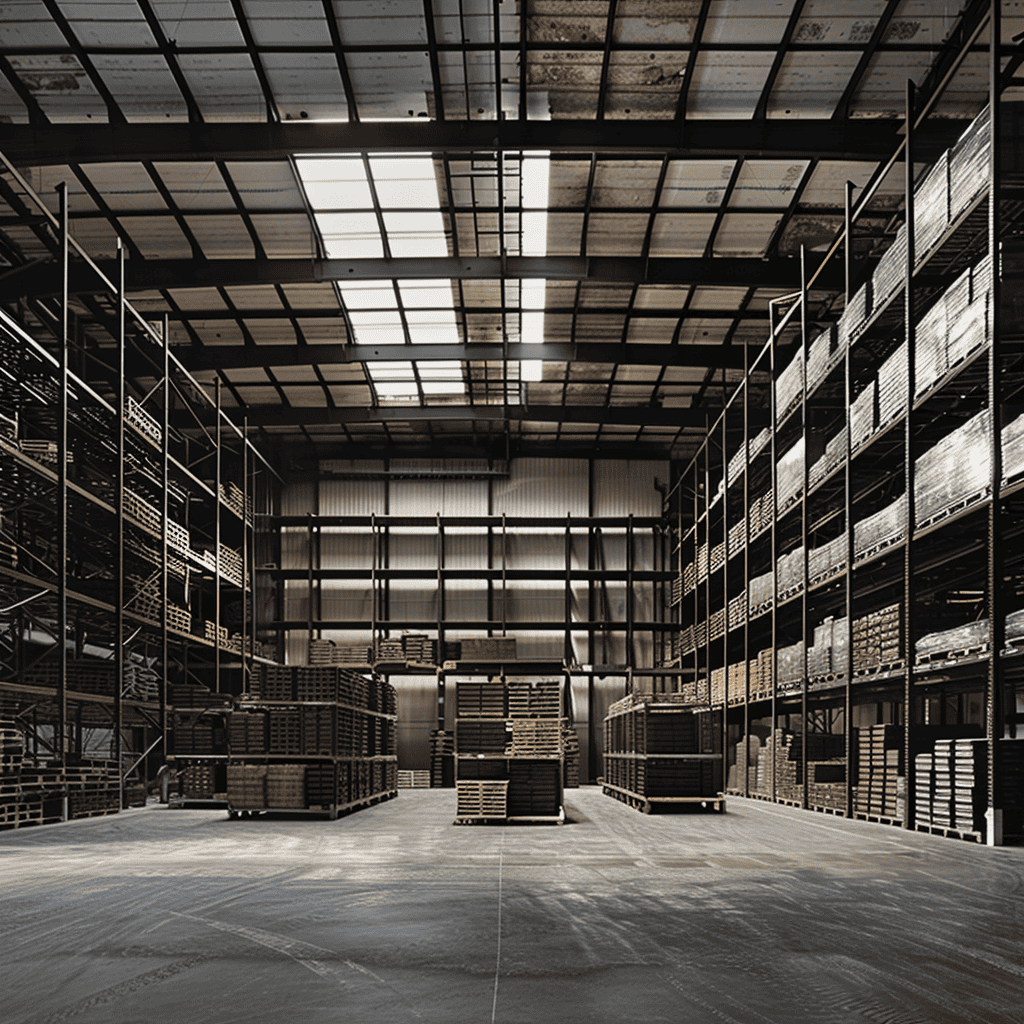In the dynamic world of logistics and supply chain management, the size of a shipping warehouse plays a crucial role in determining the efficiency and effectiveness of storage and distribution operations. This comprehensive guide explores the various factors influencing warehouse sizes, the differences between small and large warehouses, and the benefits of each type for different business needs.
Evolution of Warehouse Sizes
The size of warehouses has grown significantly over the past few decades, driven primarily by the expansion of e-commerce and the need for larger, more efficient storage facilities. According to a report by CBRE, the average size of newly constructed warehouses in the U.S. has doubled since 2002, reaching approximately 184,693 square feet. This increase is attributed to the rising demand for quicker delivery times and larger inventories to meet consumer expectations.
Key Factors Influencing Warehouse Size
Several factors influence the size of a shipping warehouse, including:
- Type of Goods Stored: Different types of products require varying amounts of space. For example, large items like furniture or automobiles need more storage space than small items like electronics or clothing.
- Storage Methods: The method of storage, such as pallet racking, shelving, or automated storage and retrieval systems (AS/RS), impacts the amount of space required.
- Operational Requirements: Businesses with high turnover rates or those that handle large volumes of inventory typically need larger warehouses to ensure smooth operations.
- Technology and Automation: Advanced technology and automation can optimize space utilization, allowing for more efficient use of available space and potentially reducing the need for larger warehouses.
- Geographical Location: A warehouse’s location can also affect its size. Warehouses in urban areas may be smaller due to higher real estate costs, while those in rural areas can afford to be larger.
Average Size of Shipping Warehouses
The average size of shipping warehouses varies widely depending on the industry and specific business requirements. On average, U.S. warehouses are around 180,000 square feet. However, this can range from small warehouses of 10,000 to 25,000 square feet for startups and small businesses to large facilities exceeding 500,000 square feet for well-established companies with extensive inventory needs.

Small Warehouses
Small warehouses, typically ranging from 10,000 to 25,000 square feet, are ideal for startups and small businesses. These warehouses offer several advantages:
- Cost-Effective: Small warehouses are generally more affordable to rent or purchase, making them a cost-effective option for businesses with limited budgets.
- Flexibility: These facilities often offer more flexible lease terms and can be easily scaled up or down based on business needs.
- Proximity to Customers: Small warehouses are often located in urban areas, providing closer proximity to customers and reducing shipping times.
- Personalized Service: Smaller facilities can offer more personalized service, catering to the specific needs of the business and its customers.
However, small warehouses also have limitations, such as restricted storage capacity and fewer advanced technological features than larger facilities.
Large Warehouses
Large warehouses, which can exceed 500,000 square feet, are suitable for well-established businesses with significant inventory volumes. These facilities offer several benefits:

- Advanced Technology: Large warehouses are often equipped with state-of-the-art technology and automation, improving efficiency and reducing errors.
- Specialized Storage Solutions: These warehouses can accommodate specialized storage needs, such as climate-controlled areas for perishable goods or high-security areas for valuable items.
- Economies of Scale: Large warehouses can take advantage of bulk pricing discounts due to their high order volumes, leading to cost savings.
- Comprehensive Fulfillment Capabilities: These facilities can handle complex fulfillment operations, including automated picking and packing systems and real-time inventory tracking.
Despite these advantages, large warehouses also have higher costs and increased operational complexity. They may require more advanced systems and personnel to manage effectively.
Choosing the Right Warehouse Size for Your Business
Selecting the appropriate warehouse size is a critical decision for any business. Here are some key considerations to help you make the right choice:

- Inventory Volume: Assess your current and projected inventory volumes to determine the amount of storage space needed.
- Fulfillment Speed: Consider the speed at which you need to fulfill orders. Smaller warehouses may offer shorter lead times, while larger warehouses can handle higher volumes.
- Budget: Evaluate your budget for renting or purchasing a warehouse, as well as ongoing operating costs.
- Location: Choose a location that balances cost with proximity to your customer base to minimize shipping times and costs.
- Scalability: Ensure the warehouse can accommodate your business’s growth. Flexible lease terms and the ability to scale operations are important factors.
- Technology Needs: Determine the level of technology and automation required for your operations. Larger warehouses may offer more advanced features, but smaller warehouses can still be efficient with the right systems in place.
Benefits of Small vs. Large Warehouses
Understanding the benefits of small and large warehouses can help businesses make an informed decision about which type best suits their needs.
Benefits of Small Warehouses
- Lower Costs: Smaller warehouses are generally less expensive to rent or purchase, making them suitable for businesses with limited budgets.
- Flexibility: These facilities often offer more flexible lease terms and can be easily customized to meet specific business needs.
- Proximity to Customers: Being located closer to urban areas, small warehouses can reduce shipping times and costs.
- Personalized Service: Smaller facilities can provide more tailored services, enhancing the customer experience.
Benefits of Large Warehouses
- Advanced Technology and Automation: Large warehouses are equipped with state-of-the-art technology, improving efficiency and reducing operational errors.
- Specialized Storage Solutions: These facilities can accommodate a wide range of storage needs, from climate-controlled areas to high-security zones.
- Economies of Scale: High order volumes allow large warehouses to take advantage of bulk pricing discounts, reducing costs.
- Comprehensive Fulfillment Capabilities: Large warehouses can handle complex fulfillment operations, including automated picking and packing systems and real-time inventory tracking.
How big is the average shipping warehouse in the U.S.?
The average size of a shipping warehouse in the U.S. is approximately 180,000 square feet. This size has increased significantly over the past few decades due to the growth of e-commerce and the need for larger storage facilities to handle higher inventory volumes and faster turnover rates.
What factors influence the size of a shipping warehouse?
Several factors influence the size of a shipping warehouse, including the type of goods stored, storage methods, operational requirements, technology and automation, and geographical location. These factors determine how much space is needed to store and manage inventory efficiently.
What are the benefits of a small warehouse?
Small warehouses, typically ranging from 10,000 to 25,000 square feet, offer several benefits:
- Lower costs for rent or purchase
- Greater flexibility in lease terms and scalability
- Closer proximity to customers, reducing shipping times
- More personalized service tailored to specific business needs
What are the advantages of a large warehouse?
Large warehouses, which can exceed 500,000 square feet, provide numerous advantages:
- Advanced technology and automation, improving efficiency and reducing errors
- Specialized storage solutions, such as climate-controlled areas and high-security zones
- Economies of scale, allowing for bulk pricing discounts
- Comprehensive fulfillment capabilities, including automated picking and packing systems and real-time inventory tracking
How do I choose the right warehouse size for my business?
To choose the right warehouse size for your business, consider the following factors:
- Inventory volume: Assess your current and projected inventory needs.
- Fulfillment speed: Determine the speed required to fulfill orders.
- Budget: Evaluate the cost of renting or purchasing a warehouse and ongoing operating expenses.
- Location: Choose a location that balances cost with proximity to your customer base.
- Scalability: Ensure the warehouse can accommodate your business’s growth.
- Technology needs: Determine the level of technology and automation required for your operations.
What are the challenges of managing a large warehouse?
Managing a large warehouse can present several challenges, including higher costs, increased operational complexity, and the need for advanced systems and personnel. Large warehouses may also be located farther from end customers, potentially impacting shipping times and costs.
Are there specific industries that require larger warehouses?
Yes, certain industries require larger warehouses due to the nature of their products and operational needs. These industries include e-commerce, manufacturing, and those dealing with large or bulky items, high inventory turnover rates, or specialized storage requirements such as climate control or high security.
How has e-commerce influenced the size of warehouses?
E-commerce has significantly influenced the size of warehouses by increasing the demand for larger facilities to handle higher inventory volumes and faster turnover rates. The rise of online shopping has led to the need for more extensive storage and efficient fulfillment operations, resulting in larger warehouse sizes.
Conclusion
The size of a shipping warehouse is a crucial factor in the efficiency and effectiveness of logistics and supply chain operations. Small warehouses offer cost-effective, flexible solutions for startups and small businesses, while large warehouses provide advanced technology and comprehensive fulfillment capabilities for well-established companies. By carefully considering factors such as inventory volume, fulfillment speed, budget, location, scalability, and technology needs, businesses can select the right warehouse size to optimize their operations and achieve their goals.

